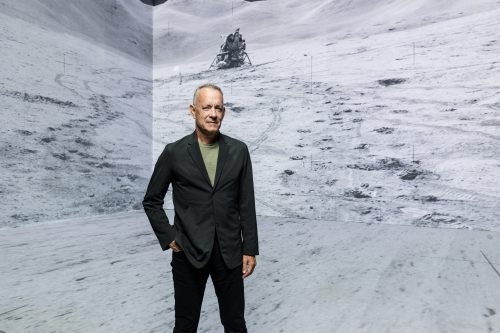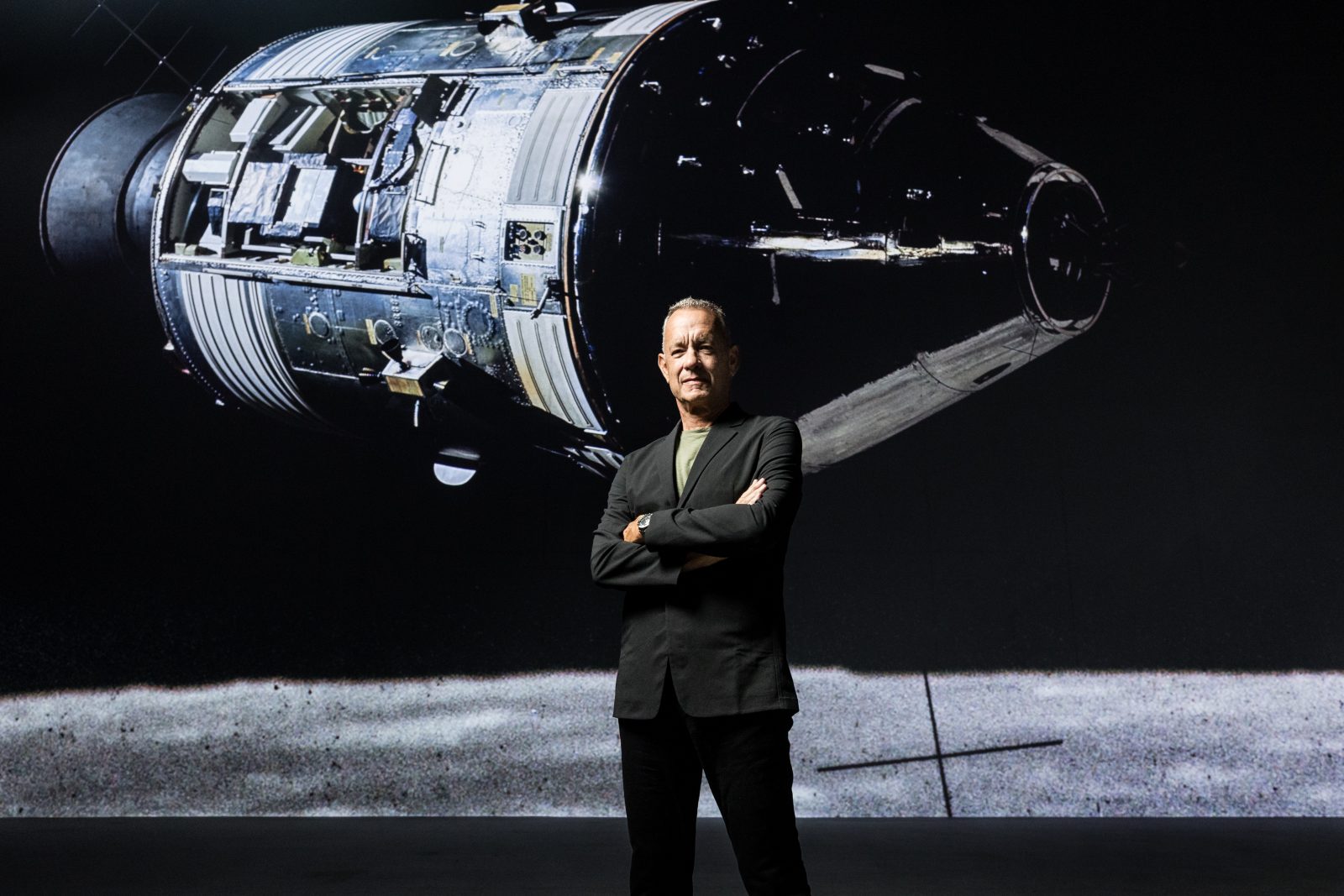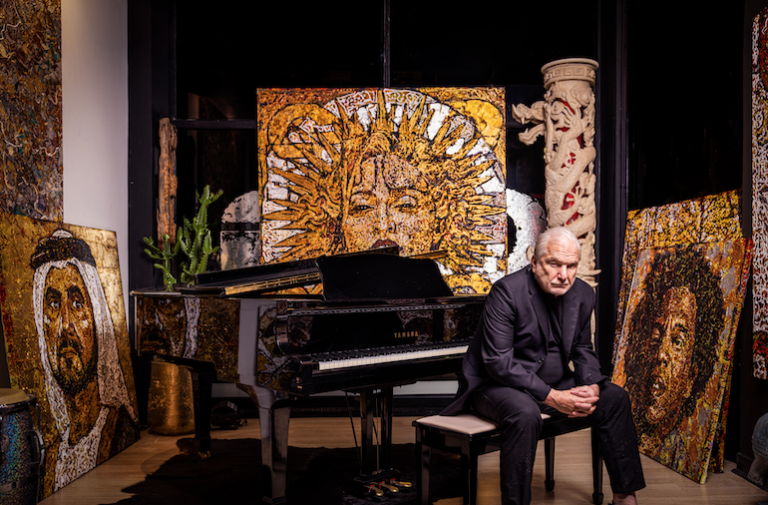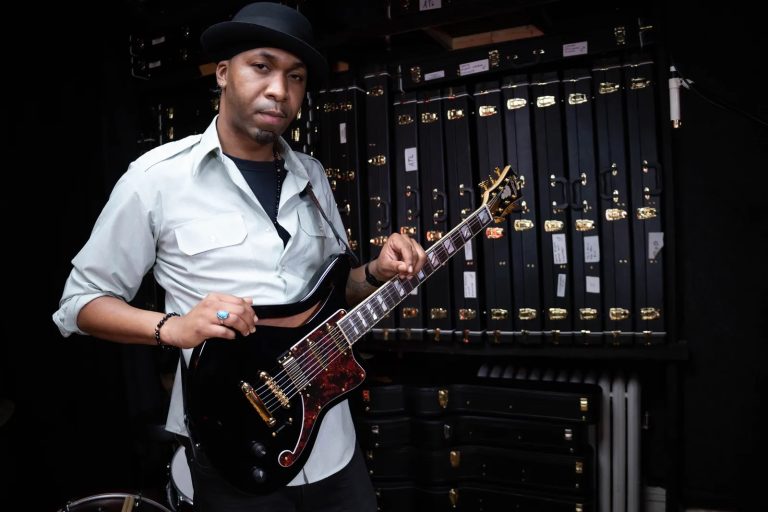The solar system’s mysteries & endless possibilities have always fascinated Tom Hanks. This summer the 7x Grammy, 4x Golden Globe and 2x Academy Award winner takes Boston on an out of this world experience to explore ‘Moonwalkers’ with him at Saunders Castle at Park Plaza.
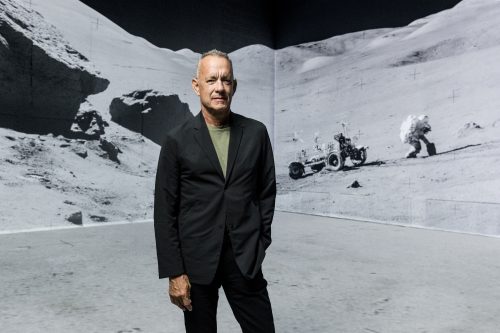
FOR MOST OF US, walking on the moon will always remain the stuff of dreams. But this summer in Boston, Tom Hanks is getting us as close as we’ll ever come.
“The Moonwalkers: A Journey with Tom Hanks” has officially landed in Boston, transforming the historic Saunders Castle at Park Plaza into a dazzling immersive voyage through time, technology, and outer space. The 50-minute experience surrounds visitors with 360° floor-to-ceiling projections, visceral spatial audio, and decades of rare NASA footage—all brought to life by the impassioned voice of a lifelong space geek: Hanks himself.
A Personal Vision Becomes Reality
The genesis of “The Moonwalkers” reads like a Hollywood story itself. When Hanks visited the Lightroom venue in London for an art exhibition by his friend David Hockney which opened in 2023, he was accompanied by close friends who happened to be Elton John and Paul McCartney, but it was Hanks who saw something extraordinary in the space. As producer Mark Fraser-Davidson recalls, Tom looked around the immersive environment and simply said, “I can see people walking on the moon in here.”
That moment of inspiration led to something unprecedented. Unlike typical celebrity endorsements, Hanks didn’t just lend his name to the project—he conceived it, co-wrote it, and produced it. “Tom’s not just a name associated with the project,” Fraser-Davidson explains. “He conceived and wrote it, and it’s been his passion.”
The two-time Oscar winner’s fascination with space exploration runs deep, rooted in childhood wonder. In a CBS News interview about the experience, Hanks reflected on a pivotal moment: “I was sitting at home in December of 1968 when Bill Anders, Jim Lovell and Frank Borman broadcast a live TV message from the moon. I remember thinking to myself, ‘I am so glad I’m 13-years-old and I’m alive at the moment that we as a species go from never being on the moon to having been to the moon and I bought all the little models and all the little toys.'”
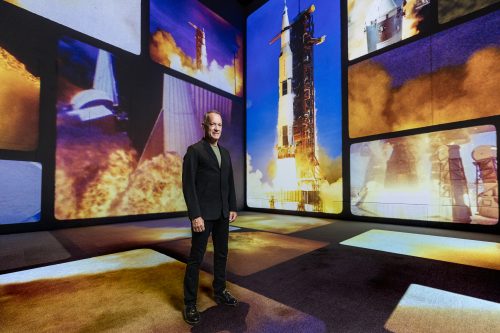
The Technical Marvel
Walking into “The Moonwalkers” is unlike entering any traditional theater. The venue itself immediately sets the stage for something extraordinary. Rather than conventional seating, guests choose their own vantage point: stadium seats floating up one wall, cushioned ledges, scattered benches, or simply stretching out on the floor, where many children instinctively gravitate.
The technical specifications are staggering. High-definition projectors beam images onto all four walls and the floor, creating a true 360-degree immersive environment. The projectors reach 27 feet in the air, with some elements extending 30 feet high. The hard walls allow guests to sit directly against the projection screens, creating an unprecedented sense of intimacy with the imagery.
But it’s the audio technology that truly transforms the experience. The sound system is so powerful it physically shakes the entire space, elevating heartbeats and creating visceral reactions to the rocket launches. The orchestral score, composed by Anne Nikitin and recorded at the legendary Abbey Road Studios with the Royal Philharmonic Orchestra, envelops listeners in waves of emotion that perfectly complement the visual spectacle.
As Fraser-Davidson describes it, the audio “resonates and shakes through the entire building. It changes your heartbeat. and with that, elevates the entire experience.”
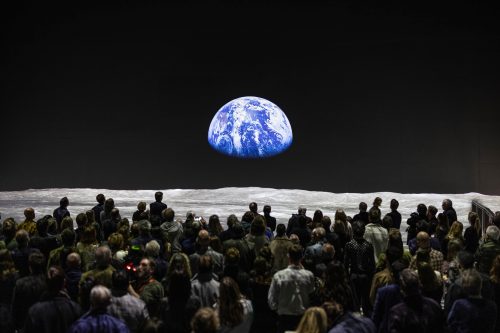
Authenticity Above All
What sets “The Moonwalkers” apart from other immersive experiences is its unwavering commitment to authenticity. Every single image in the 50-minute presentation comes from NASA’s archives—35,000 photos and 10 hours of meticulously remastered film footage. There are no computer-generated special effects, no artistic interpretations, no Hollywood embellishments.
“Every image in that show is from the NASA archives. There was no CGI in that show. It’s all photography. Every image was taken by a human behind the camera lens,” emphasizes Richard Slaney, CEO of Lightroom and producer of the experience. “It has that sense of humanity throughout it. That’s what makes it an emotional show.”
The 70mm film was re-scanned and processed to produce stunning color and depth, with a sharpness that’s almost otherworldly due to the lack of atmospheric interference in space. This pristine quality is part of what makes the lunar imagery so compelling.
“There are archival images used in this show that have never been seen by the public before,” Fraser-Davidson added. “Being able to collaborate with NASA and look at the original archive photos of the Moon Landings, they’ve been able to create this wholly factual 50 minute immersive show.”
The selection includes intimate moments like the family photo that Apollo 16 astronaut Charlie Duke left on the lunar surface, bringing deeply personal elements to the grand historical narrative.
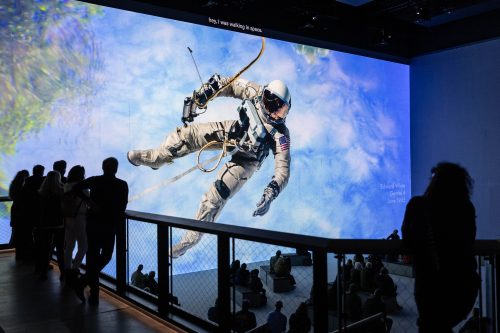
The Hanks Touch
Tom Hanks serves as more than just a narrator—he becomes a personal guide through humanity’s greatest adventure. His approach is conversational and intimate, as if recounting memories on a Sunday drive. The script weaves together historical facts with personal reflection, creating an emotional connection that transcends mere documentation.
“The story is actually a story of hope. Of course, it’s about hope of humanity, of what we can do when we work together,” Hanks explained in a BBC interview about the experience. “The only reason to go to the moon was because we’re human beings and we desire to figure out what is on the other side of the hill and that affected me very much then.”
The experience becomes particularly powerful when Hanks reflects on meeting actual astronauts. As he told CBS News, “It’s like meeting the Beatles. They’re like, ‘oh, hey Tom, I really enjoyed that show you made.’ I can’t believe these guys know my name. There isn’t one of them who doesn’t talk about how much fun it was to play in zero gravity.”

A Journey Through Time
The experience encompasses multiple Apollo missions and the twelve astronauts who walked on the moon, though the majority of time focuses on Apollo 11 and the historic first landing with Neil Armstrong, Buzz Aldrin, and Michael Collins on July 21, 1969. The deafening launch sequence is viscerally gripping, while the lunar module’s blast-off from the moon’s surface to reunite with the command module creates an almost impossible-to-describe sense of magnitude.
At one transformative moment, a panoramic view of the moon’s surface spreads across the entire performance space, placing audiences directly on the rocky lunar terrain. The topographical map reveals the moon’s hills and valleys in stunning detail, while projections of the lunar surface appear beneath guests’ feet, creating the perspective of viewing Earth from space.
The show explores the scientific achievements of the Apollo missions, from lunar field geology and solar wind research to passive seismic experiments. But it also captures the playful moments—astronauts exploring the lunar surface with the joy of children discovering a new playground.
Despite the scope of these incredible accomplishments, “The Moonwalkers” presents the astronauts as remarkably modest individuals who went about their lives like anyone else, doing their jobs and enjoying time with their families. This human element is what makes the experience so emotionally resonant.
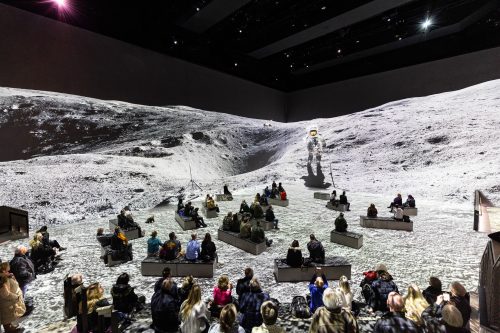
Looking Forward
“The Moonwalkers” doesn’t just celebrate past achievements; it bridges the gap to the future. The experience includes new interviews with astronauts from the Artemis program, which is projected to return humans to the moon in 2026. These conversations provide insight into the next generation of lunar exploration and the excitement surrounding missions that will include the first woman and first person of color to walk on the moon.
The technological advances since the 1970s add another layer of wonder to the story. As Slaney points out, “They were going to the moon powered by a computer that was a tenth as powerful as the phone in your pocket. They were calculating things on pen and paper. Hopefully, next year, a new generation will have that moment, too.”
Hanks himself remains optimistic about the future of space exploration, viewing it as a unifying force in an often-divided world. As he noted in a Space.com interview, “When we do it again—and we will—we will be doing it because these were the Pathfinders who showed it was possible in the first place.”
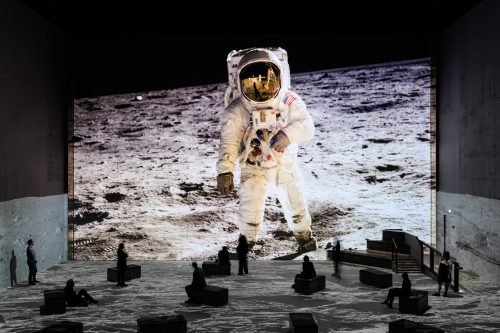
The Boston Experience
The Boston presentation of “The Moonwalkers” runs through August 31 at The Saunders Castle at Park Plaza on Columbus Avenue. The venue’s historic character adds to the experience, providing a destination that feels special rather than merely functional. The castle setting creates an atmosphere of grandeur appropriate for humanity’s greatest adventure. Tickets range from $35-$50, and the experience includes a pre-show exhibition area with spectacular photos, behind-the-scenes video interviews, and a replica of the lunar module Eagle- the original continues to orbit the moon.
Since opening at the Saunders Castle, “The Moonwalkers” has left Boston audiences visibly moved, wide-eyed, and often speechless.
“I’ve never seen anything like it,” said Danielle Ramos, a South End resident who brought her two sons. “You feel like you’re inside history. I didn’t expect to get emotional, but when the rockets launched and Tom Hanks started narrating, I actually teared up. Only he could make this both epic and personal.”
The sense of pride in having such a world-class production in the city was a recurring theme. “Usually something like this would be in New York or D.C.,” said Sean Mitchell, a retired engineer from Cambridge. “The fact that it’s right here in Boston, in a venue like the Castle, makes it even more special. It’s awe-inspiring.”
Visitors were especially impressed with Hanks’ presence in the production—not just as a voice, but as a storyteller. “You can tell it means something to him,” said Leah Vrees, a student at Northeastern. “It’s not just narration. It’s like he’s letting you into his own memories. It makes everything feel human.”
Seven-year-old Ezra had perhaps the most succinct review: “That was cooler than my birthday and Halloween combined.”
For many, the immersive scale of the visuals and sound added a transformative layer. “You’re not watching a movie—you’re in it,” said Jamal Haynes, who came in from Worcester. “You can feel the moon dust under your feet. The sound rattles your chest. It’s science, art, and emotion all in one.”

A Lasting Legacy
“The Moonwalkers: A Journey with Tom Hanks” represents more than entertainment; it’s a celebration of human achievement and curiosity. In an era of division and uncertainty, it reminds us of what we can accomplish when we work together toward a common goal. As Hanks eloquently stated during a BBC interview, “For myself when I was 13 the Apollo missions were this example of the… evolutionary place in the consciousness of humankind because the only reason to go to the moon was because we’re human beings and we desire to figure out what is on the other side of the hill.”
The experience leaves audiences with a renewed sense of wonder and possibility. It’s a reminder that in 1969, against all odds and with technology primitive by today’s standards, humans walked on the moon. And as we prepare for the next chapter of lunar exploration, “The Moonwalkers” ensures that the spirit of that achievement—and the inspiration it provides—will not be forgotten.
In the words of producer Mark Fraser-Davidson, “I’ve sat through this show four or five times here in Boston, and still each time I see it, I think that’s new, I’ve never seen that before, simply because there’s so much around you to take in. There is a generation of people who don’t quite remember the original landings. But with the upcoming Artemis missions scheduled to return to the moon, It’s time for a new generation of excitement to begin.”
For those fortunate enough to experience “The Moonwalkers” in Boston, it truly is, as Hanks envisioned, “the closest you could get to walking on the moon.”
